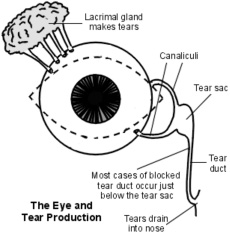Watery Eyes
Who gets watery eyes?
Understanding normal tears
What are the possible causes of watering eyes?
Do I need any tests?
What is the treatment for watering eyes?
Who gets watery eyes?
Watering eyes (tears rolling onto your cheeks) can occur at any age, but is most common in young babies and in people over the age of 60. It can occur in one or both eyes.
Understanding normal tears
Just above, and to the outer side, of each eye is a small gland called the lacrimal gland. This constantly makes a small amount of tears. When you blink the eyelid spreads the tears over the front of the eye to keep it moist.
The tears then drain down small channels (canaliculi) on the inner side of the eye into a tear 'sac'. From here they flow down a channel called the tear duct (also called the naso-lacrimal duct) into the nose.
What are the possible causes of watering eyes?
Making too many tears
- Emotion can make you cry.
- Anything that irritates the eye can cause you to make a lot of tears. The watering is a protective reflex to help clear irritants away from the eye. For example:
• Dry eyes are actually the most common cause of reflex watering.
• Chemical irritants such as onions, fumes, etc.
• Infection of the front of the eye (infective conjunctivitis).
• An allergy causing inflammation of the front of the eye (allergic conjunctivitis).
• A small injury or scratch to the front of the eye, or a piece of dirt or grit which gets stuck in the eye.
• Eyelashes that grow 'inwards' can irritate the front of the eye. This is called an entropion.
- Abnormalities of the tear film. For example, the lipid (fat) content of tears may not be right. The tear film may then not spread evenly across the front of the eye. This may cause patches of dryness to develop, which can become sore and make your eyes water.
Faulty drainage of tears
- Tears may become blocked at any point in the drainage channels.
• A common cause of watering eye in adults is a blockage in the tear duct just below the tear sac. This is thought to be due to a gradual narrowing of the upper end of the tear duct, perhaps caused by persistent mild inflammation. If you have a blocked tear duct, not only will you have watering eyes, but the stagnant tears within the tear sac may become infected. If the tear sac gets infected you will also have a sticky discharge on the eye. You may also develop a painful swelling on the side of the nose next to the eye.
• Sometimes the tear duct is not blocked fully, but is too narrow to drain all the tears.
• Less commonly there may be a blockage within the canaliculi, or the entrance to the canaliculi in the inner corner of the eye may be blocked. This may be due to inflammation or scarring.
• Rarely, a polyp in the nose may block the tears from coming out of the tear duct.
- Some babies are born with a tear duct which has not fully opened. This is common and usually clears within a few weeks without any treatment as the tear duct opens fully.
- Ectropion. This is where the lower eyelid turns outward away from the eye. The ectropion may cause tears to roll off the bottom of the eyelid rather than drain down the canaliculi to the tear sac.
Do I need any tests?
Sometimes the cause is easily identified. For example: infections, ectropion, entropion, conjunctivitis. If there is no obvious cause by a simple examination, further tests may be advised. These may depend on how bad the watering is, and how much it bothers you.
If a drainage problem is suspected, an eye specialist may examine the tear drainage channels by syringing under local anaesthetic. Syringing may sometimes clear a blockage, but it may only give temporary relief. It will demonstrate where there is any obstruction or narrowing of the tear duct.
What is the treatment for watering eyes?
Treating eye irritation
Quite often the cause can be treated. For example:
- Eyelashes irritating the front of the eye can be removed.
- Conjunctivitis can usually be treated with drops.
- Pieces of grit, etc, can be removed
Treating tear drainage problems
- Ectropion can usually be treated with a minor operation to the lower eyelid.
- Babies with watery eyes usually 'grow out of it' with no treatment
- Blockage of the channels in adults.
• You may not need treatment if the watering is mild or does not bother you much.
• A narrowed canaliculi which is not fully blocked may be widened by pushing in a probe. However, if it is completely blocked an operation is an option to drain the tears into the nose.
• The openings to the canaliculi (the puncta) can be widened to allow tears to flow freely into the drainage system
• A blocked tear duct can be treated with an operation. The usual operation is called DCR (dacrocystorhinostomy) where a new channel is made from the tear sac to the inside of the nose. Tears then bypass any blockage further down the tear duct.


